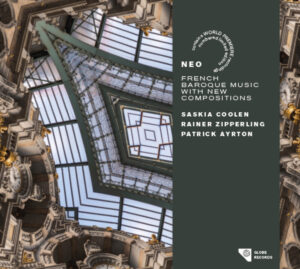2024
Recorders (sopranino, soprano, voice flute), viola da gamba, harpsichord
16'30" ca
For the trio trio Saskia Coolen (recorders), Rainer Zipperling (viola da gamba) and Patrick Ayrton (harpsichord).
Commissioned by Saskia Coolen.
In dedication to the memory of Saskia's parents, Margot Wu Lung Hing en Henk Coolen.
1. Ouverture à Deux
2. Querelle des Soupçons
3. Tambourin Lointain
4. Les Caractères Imprévus
 This piece was written especially at the request of the trio of Saskia Coolen, Rainer Zipperling and Patrick Ayrton for their CD Neo: The Burgundy Sessions. It is their foray into the French Baroque, featuring Couperin, Marais and Rebel, but also new music by Torben Klaes, Calliope Tsoupaki and myself.
This piece was written especially at the request of the trio of Saskia Coolen, Rainer Zipperling and Patrick Ayrton for their CD Neo: The Burgundy Sessions. It is their foray into the French Baroque, featuring Couperin, Marais and Rebel, but also new music by Torben Klaes, Calliope Tsoupaki and myself.
Not only did Saskia Coolen ask me to write a piece for their ensemble of recorder, gamba, and harpsichord, but she also wanted to dedicate that piece to her deceased parents. A great honour, which I accepted with deep love. Her request immediately plunged me into the world of the French Baroque, for me a new and unexplored inspiration. Playing on Saskia’s mother’s harpsichord, I was thrilled to discover the unprecedented clarity and dynamic subtlety of this ensemble of instruments, which is both brilliant and transparent, loving and fiery simultaneously.
It seemed beautiful and appropriate to look for inspiration in love songs when dedicating such a commission to her parents; thinking of L’Europe Galante, André Campra’s first “opera-ballet” of 1697, I imagined bringing together folk songs from all over the continent with love as a theme into an opéra-ballet-like composition of lilting melody and dancing rhythm.
However, through my conversations with Saskia, I began to see Europe very differently.
Saskia’s harpsichord-playing mother’s ancestors hail from China and Africa via Suriname, while my ballet-dancing mother’s roots may be traced back to Java.
Thus, for our mothers, Europe was not a land of origin but rather a land of the future, the terminus of a journey that took them to their loved one.
That thought led me from Campra to Rameau, whose Les Indes Galantes, also an opera-ballet, in 1735, presented characters at the time deemed ‘exotic’ with the aim of stirring the aristocratic imagination. Now, three hundred years later, for many of us Dutch, precisely that once ‘exotic’ colonial legacy has become firmly rooted in our characters, resulting in a new history, a new stimulus to the imagination, and thus a new narrative.
Therefore, naturally, Rameau! The long maligned Rameau is one of the Baroque composers I hold in the highest esteem (alongside Telemann and Vivaldi.) I’m not attempting to replicate his unique style here – he is Rameau, and I am not. To embody Rameau’s style, I would need to shed the historical experiences of the intervening centuries that, despite myself, shape my ‘exotic’ self.
Rather, his example lies above all in that unparalleled penchant for the dance-like in which folk dance inevitably breaks through the surface, in the rhythmic invention he then displays, in his skill at creating ‘characters’ and in the pace of their actions, his cunning sense of humour – in short, in everything that makes an opera an opera and a ballet a ballet. And, of course, in his effervescent harmonies.
Thus, L’Europe des Amants became a series of lighthearted character pieces with the personal histories of Saskia’s parents, Margot Wong Lun Hing and Henk Coolen, in the background. Therefore, don’t be surprised that in L’Europe des Amants, both Baroque sequential harmony and un-eighteenth-century modal sounds creep into the Ouverture (à Deux), that in the Tambourin Lointain a Surinam folk song pops up, and that a mildly mournful Passacaille and increasingly nervous Gigue finally embrace each other solemnly and lovingly.
.